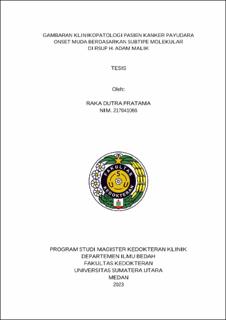Gambaran Klinikopatologi Pasien Kanker Payudara Onset Muda Berdasarkan Subtipe Molekular di RSUP H. Adam Malik
Clinicopathological Features of Young-Onset Breast Cancer Patients Based on Molecular Subtypes at H. Adam Malik Hospital

Date
2023Author
Pratama, Raka Dutra
Advisor(s)
Pohan, Pimpin Utama
Hermansyah, Dedy
Metadata
Show full item recordAbstract
Introduction: Breast cancer is a major global health issue, and its incidence among young women (aged <40 years) is increasing. This study aims to analyze the clinicopathological features of young-onset breast cancer (YOBC) patients at H. Adam Malik Hospital, Medan, focusing on molecular subtypes and their association with clinical outcomes. YOBC tends to present with more aggressive disease and poorer prognosis than in older women, often showing higher grades and more advanced stages at diagnosis.
Methods: This descriptive observational study with a cross-sectional design reviewed medical records of breast cancer patients aged <40 years treated at H. Adam Malik Hospital from January 2017 to December 2022. Data on demographics, tumor characteristics, lymph node involvement, metastasis, histopathology, and molecular subtypes (Luminal A, Luminal B, HER-2 positive, and triple-negative breast cancer) were collected and analyzed descriptively.
Results: A total of 104 patients were included. The mean age was 35.8 years (SD 4.05), with a median age of 37 years. The majority of patients presented with advanced disease (stage IV: 51%), large tumors (T4: 69.2%), and significant lymph node involvement (N1: 55.8%). Invasive ductal carcinoma (IDC) was the most common histopathological type (46.2%), and poorly differentiated tumors (Grade III) were predominant (39.4%). The HER-2 positive molecular subtype was the most frequent (37.5%), followed by Luminal B (29.8%) and triple-negative (21.2%). Most cases had negative estrogen receptor (ER: 69.2%) and progesterone receptor (PR: 68.3%) expression, while HER-2 expression was positive in 59.6% of patients.
Conclusion: YOBC at H. Adam Malik Hospital is characterized by advanced-stage disease, aggressive histological features, and a predominance of HER-2 positive and Luminal B molecular subtypes. These findings emphasize the need for early detection and targeted therapeutic strategies in this population.
